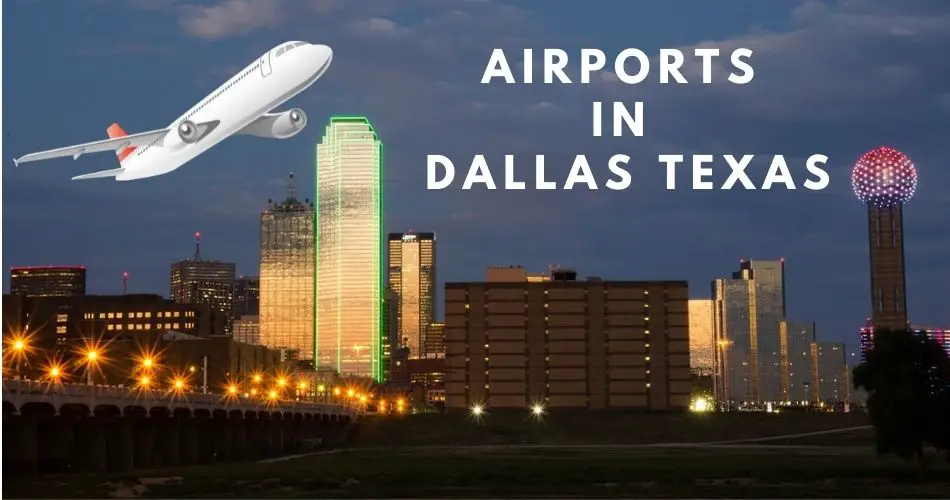There are two major airports in Dallas Texas; Dallas/Fort Worth International Airport and Dallas Love Field Airport. These Dallas TX Airports operate scheduled commercial flights to various domestic and international destinations.
Dallas/Fort Worth International Airport also known as DFW Airport is the prime international airport serving Dallas-Fort Worth. Dallas Love Field Airport is a city-owned public-use airport located 6 miles northwest of downtown Dallas, Texas.
Dallas Love Field was the primary airport before the operation of Dallas/Fort Worth International Airport.
Let’s dig into more details on these two Dallas TX Airports in this article.
Top 2 Dallas TX Airports
Table of Contents
Dallas/Fort Worth International Airport (Dallas TX Airports)
Dallas/Fort Worth International Airport (ICAO: KDFW, IATA: DFW, FAA LID: DFW) is the main international airport operating in Dallas-Fort Worth. It is one of the busiest airports in the United States in terms of passenger traffic. The airport is also the primary hub for American Airlines.
As per the 2020 statistics, the airport is the third-busiest in the world in terms of aircraft movements and the fourth-busiest in the world in terms of passenger traffic. It is also the second-largest single airline hub across the globe and the United States.
History of DFW Airport
The plan for developing a joint airport with Fort Worth was proposed by Dallas however, it got rejected as the Fort Worth City opened two airports named Love Field and Meacham Field.
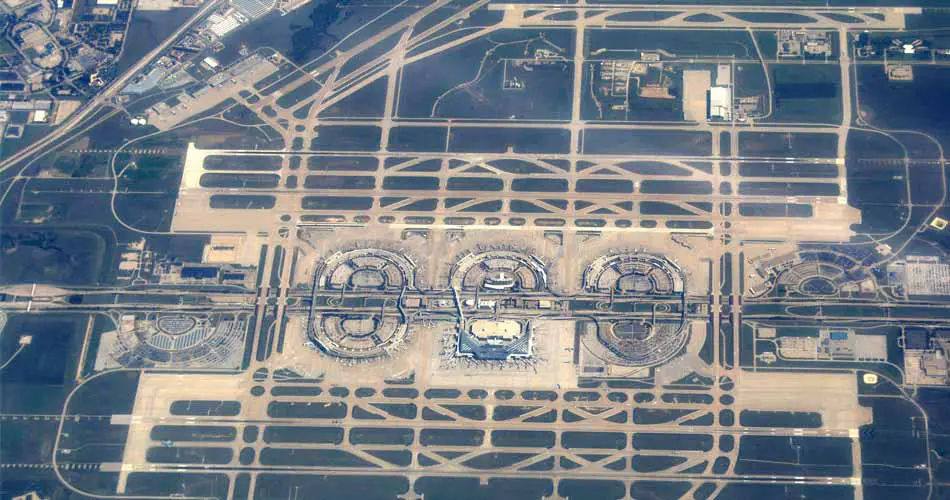
The governments of Dallas and Fort Worth disagreed over the decision of constructing Dallas/Fort Worth Regional Airport by the Civil Aeronautics Administration with an estimated budget of US$1,900,000.
The airport was planned to be constructed in the city of Arlington however, the site was annexed by Fort Worth after World War II and later developed into Amon Carter Field. American Airlines played a big part in developing this field. Fort Worth started operating commercial flights from this airport instead of Meacham Field.
The Amon Carter Field was later renamed to Greater Southwest International Airport (GSW) after Fort Worth purchased it to compete with Dallas airport. The GSW airport wasn’t performing well due to the less amount of traffic. Dallas outnumbered the air traffic of Texas with 49 per cent however, Fort Worth only managed to secure 1 per cent of Texas air traffic.
The GSW and Meacham Airport couldn’t operate smoothly following the decline of air traffic. On the other hand, Dallas Love Field experienced congestion and had no options for expansion. With that, the construction of a new airport was a necessity and the two cities (Dallas and Fort Worth) finally agreed to build a new regional airport.
The new regional airport named North Texas Regional Airport was on the verge of initiating construction however, the majority of Dallas residents preferred the Dallas Love Field Airport. With multiple attempts and negotiations, both Dallas and Fort Worth agreed to operate a new regional airport with a board team consisting of seven members from Dallas and four from Fort Worth.
Dallas/Fort Worth Airport opened on September 20, 1973, in which a supersonic Concorde owned by Air France made the first landing. The supersonic jet was on its flight from Caracas to Paris. The airport was officially inaugurated for commercial service on January 13, 1974, as Dallas/Fort Worth Regional Airport.
The regional airport was built with an estimated cost of US$700 million and American Airlines Flight 341 from New York was first to land at the airport. The regional airport was reformed to Dallas/Fort Worth International Airport after 1985.
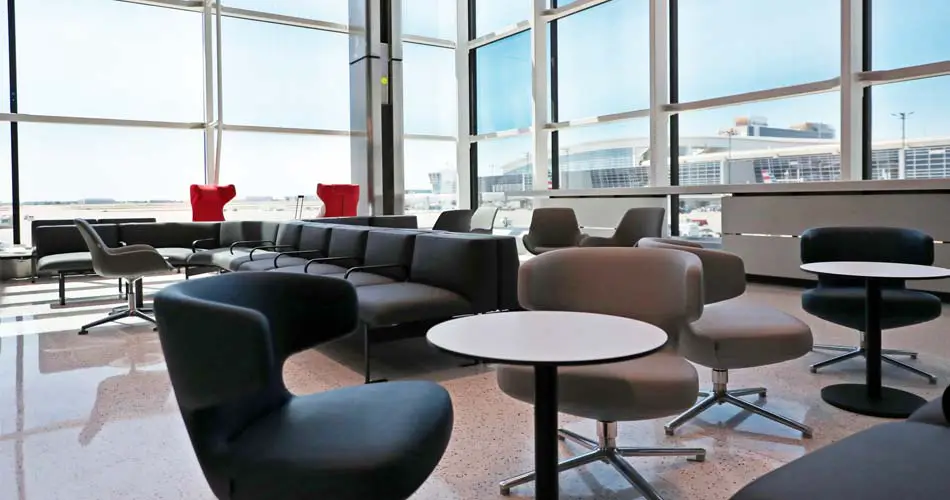
Facilities at DFW Airport
Dallas/Fort Worth International Airport features five terminals and 184 gates. Five terminals are named Terminal A, Terminal B, Terminal C, Terminal D, and Terminal E.
Terminal A contains 26 gates, Terminal B holds 55 gates, Terminal C has 28 gates, Terminal D features 32 gates and Terminal E operates 43 gates making it a total of 184 gates. The terminal of DFW airport is designed to reduce traffic around terminals and also to lessen the distance between the passenger’s vehicle and aircraft.
| DFW TERMINALS | NUMBER OF GATES |
| Terminal A | 26 gates |
| Terminal B | 55 gates |
| Terminal C | 28 gates |
| Terminal D | 32 gates |
| Terminal E | 43 gates |
Passengers can access all five terminals on the secured area with Skylink, an automatic people mover (APM) operating at Dallas/Fort Worth International Airport. In addition, a shuttle bus system connects all terminals via Terminal Link on the non-secure side. Terminal D of the DFW airport is capable of handling Airbus A380 operation.
| AIRLINES | FACILITIES AT DFW |
| American Airlines | Has gates and Admiral Clubs in all 5 terminals with a Flagship Lounge in Terminal D |
| Delta Air Lines | Sky Club in Terminal E |
| United Airlines | United Club in Terminal E |
| American Express | Centurion Lounge and The Club DFW in Terminal D |
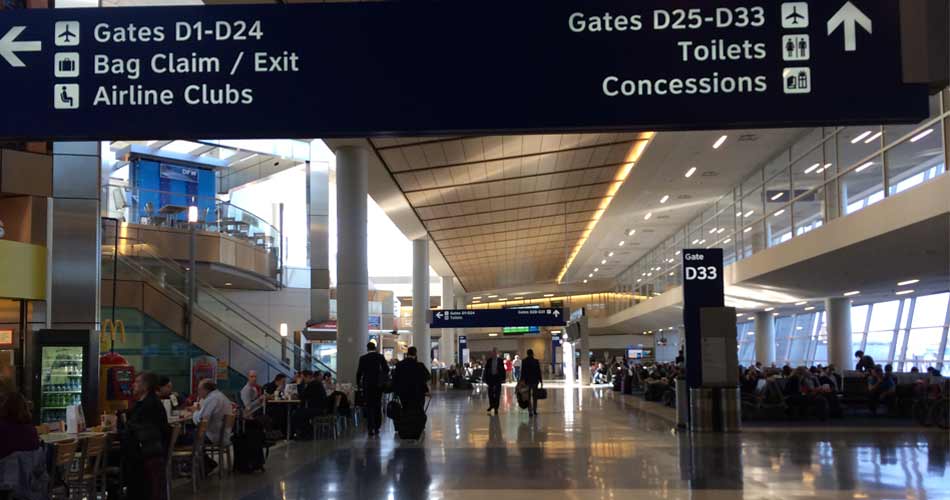
DFW Airport Runway Information
Dallas/Fort Worth International Airport features 8 runways out of which 6 are concrete runways and the remaining one is asphalt.
| RUNWAY DESIGNATION | LENGTH | SURFACE |
| 13L/31R | 9,000 ft | Concrete |
| 13R/31L | 9,301 ft | Concrete |
| 17L/35R | 8,500 ft | Concrete |
| 17C/35C | 13,401 ft | Asphalt |
| 17R/35L | 13,401 ft | Concrete |
| 18L/36R | 13,400 ft | Concrete |
| 18R/36L | 13,400 ft | Concrete |
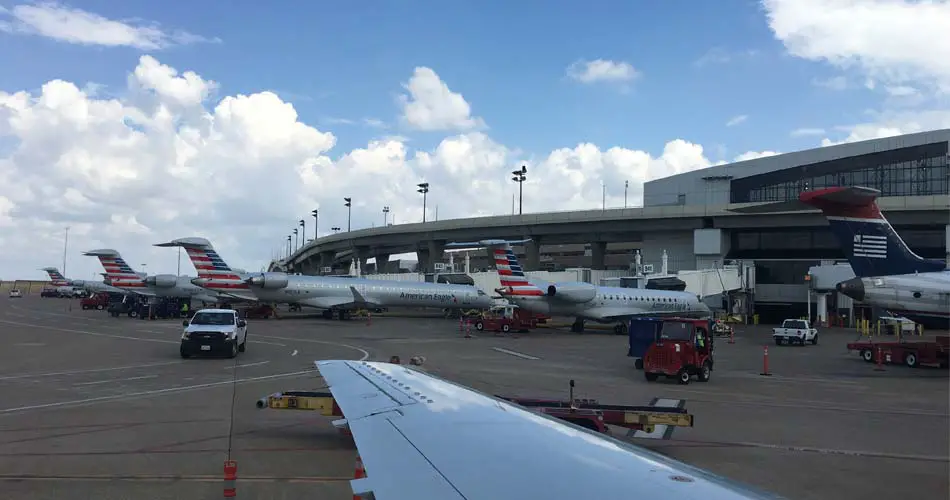
Airlines operating at DFW Airport
| AIRLINES | DESTINATIONS |
| Aeromexico Connect | Mexico City |
| Air Canada Express | Montreal, Toronto, Vancouver |
| Air France | Paris-Charles de Gaulle |
| Alaska Airlines | Portland, Seattle/Tacoma |
| American Airlines | Almost all domestic sectors, and international destinations |
| American Eagle | Almost all domestic sectors, and international destinations |
| Avianca El Salvador | San Salvador |
| Boutique Air | Carlsbad |
| British Airways | London-Heathrow |
| Contour Airlines | Greenville |
| Delta Air Lines | Atlanta, Boston, Salt Lake City, Los Angeles, Detroit, Minneapolis/St. Paul, New York-JFK, New York-LaGuardia |
| Delta Connection | Cincinnati |
| Denver air Connection | Clovis |
| Emirates | Dubai-International |
| Finnair | Helsinki |
| Frontier Airlines | Some domestic sectors and seasonal flights to Atlanta, Cancun, Chicago-O’Hare, Ontario, Nashville, Salt Lake City |
| Iberia Airlines | Madrid |
| Japan Airlines | Narita and Haneda |
| JetBlue | Boston, New York-JFK |
| Korean Air | Seoul-Incheon |
| Lufthansa | Frankfurt |
| Qantas | Sydney |
| Qatar Airways | Doha |
| Southern Airways Express | El Dorado, Harrison, Hot Springs |
| Spirit Airlines | Some domestic sectors and seasonal flights to San Diego, Myrtle Beach, Cleveland |
| Sun Country Airlines | Las Vegas, Minneapolis/St. PaulSeasonal flights to San Jose del Cabo, Punta Cana, Puerto Vallarta, Palm Springs, Orange County, Montego Bay, Libera (CR), Cozumel, Cancun |
| Turkish Airlines | Istanbul |
| United Airlines | Chicago-O’Hare, Washington, Newark, Houston, Denver |
| United Express | Chicago-O’Hare, Washington, Newark, Houston, Denver, San Francisco |
| VivaAerobus | Mexico City |
| Volaris | Guadalajara |
Major domestic destinations from DFW
| DESTINATION | OPERATING AIRLINES |
| Los Angeles | American Airlines, Delta Air Lines, Spirit Airlines |
| Las Vegas | American Airlines, Frontier Airlines, Spirit Airlines, Sun Country Airlines |
| Denver | American Airlines, Frontier Airlines, United Airlines |
| Atlanta | American Airlines, Delta Air Lines, Spirit Airlines |
| Chicago O’Hare | American Airlines, United Airlines, Spirit Airlines |
| Orlando | American Airlines, Spirit Airlines, Frontier Airlines |
| Phoenix-Sky Harbor | American Airlines, Spirit Airlines |
| Miami | American Airlines, Frontier Airlines |
| Charlotte | American Airlines |
| Fort Lauderdale | American Airlines, Spirit Airlines |
Major International destinations from DFW
| DESTINATION | OPERATING AIRLINES |
| Cancun | American Airlines, Sun Country Airlines, Spirit Airlines |
| London-Heathrow | American Airlines, British Airways |
| Mexico City | Aeromexico, American Airlines, VivaAerobus, Volaris Airlines |
| Narita-Tokyo | American Airlines, Japan Airlines |
| San Jose del Cabo | American Airlines, Spirit Airlines |
| Toronto-Pearson | American Airlines, Air Canada |
| Frankfurt | American Airlines, Lufthansa |
| Seoul-Incheon | American Airlines, Korean Air |
| Puerto Vallarta | American Airlines |
| Vancouver | Air Canada, American Airlines |
DFW Airport Technical Information
| ICAO CODE | KDFW |
| IATA CODE | DFW |
| FAA LID | DFW |
| ELEVATION | 607 ft / 185 m AMSL |
| AREA | 17,207 acres (6,963 hectares) |
| RUNWAY | 13L/31R (Concrete)13R/31L (Concrete)17L/35R (Concrete)17C/35C (Asphalt) 17R/35L (Concrete)18L/36R (Concrete)18R/36L (Concrete) |
Dallas Love Field Airport (Dallas TX Airports)
Dallas Love Field (ICAO: KDAL, IATA: DAL, FAA LID: DAL) is among the Dallas TX Airports located 6 miles northwest of downtown Dallas, Texas. It was the primary airport until the operation of Dallas/Fort Worth International Airport.
The airport covering an area of 530 hectares is situated at an elevation of 487 ft (148 m) above mean sea level (AMSL). It features two concrete runways with the designation RWY 13L/31R and RWY 13R/31L.
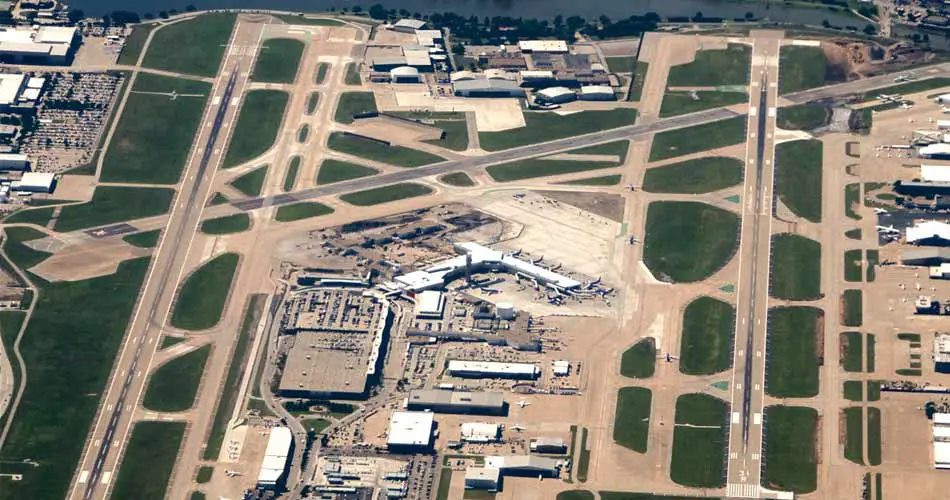
The DAL airport is named after Moss L. Love who died in an aeroplane crash near San Diego, California. He became the 10th fatality in the United States Army Aviation history. The Wright Model C biplane crashed during his practice for Military Aviator Test so, the name was kept Love Field in his memory by the United States Army on 10 October 1917.
Facilities at Dallas Love Field
Dallas Love Field features a single terminal holding 20 operational gates. Southwest Airlines operates 18 gates and the remaining 2 gates are utilized by Alaska Airlines.
Runway Information
Dallas Love Field features two concrete runways with the designation RWY 13L/31R and RWY 13R/31L.
| RUNWAY DESIGNATION | LENGTH | SURFACE |
| 13L/31R | 7,752 ft (2,363m) | Concrete |
| 13R/31L | 8,800 ft (2,682m) | Concrete |
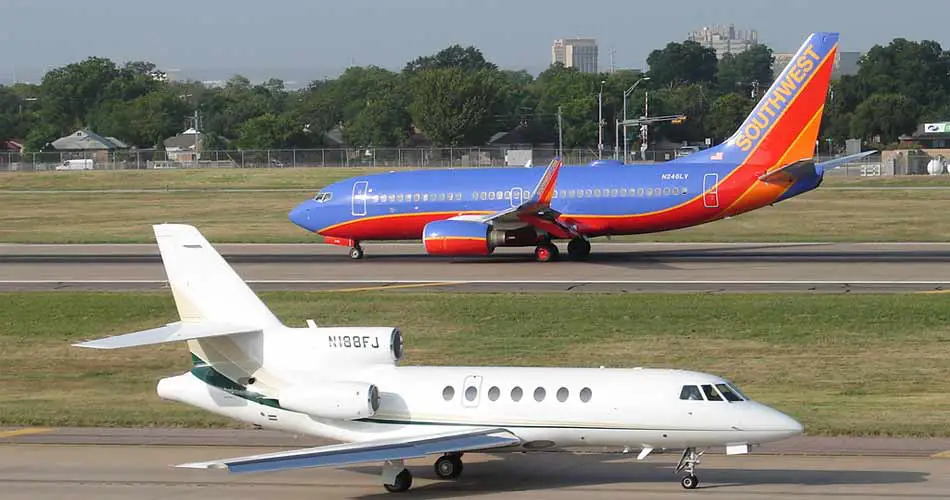
Airlines Operating at Dallas Love Field
| AIRLINES | DESTINATION |
| Alaska Airlines | Los Angeles, Seattle/Tacoma, San Francisco |
| Delta Air Lines | Atlanta |
| JSX | Austin, Houston, Las Vegas, MiamiSeasonal flights to Destin |
| Southwest Airlines | Major Domestic and International Destinations |
| Taos Air | Seasonal Flights to Taos |
Major Domestic destination from DAL
| DESTINATION | OPERATING AIRLINES |
| Denver | Southwest Airlines |
| Houston | Southwest Airlines, JSX |
| Atlanta | Southwest Airlines, Delta Air Lines |
| Phoenix-Sky Harbor | Southwest Airlines |
| Las Vegas | Southwest Airlines |
| Chicago-Midway | Southwest Airlines |
| Orlando | Southwest Airlines |
| Los Angeles | Southwest Airlines, Alaska Airlines |
| San Antonio | Southwest Airlines |
| Nashville | Southwest Airlines |
Dallas Love Field Technical Information
| ICAO CODE | KDAL |
| IATA CODE | DAL |
| FAA LID | DAL |
| ELEVATION | 487 ft (148m) |
| AREA | 530 hectares (1,300 acres) |
| RUNWAY | 13L/31R (Concrete)13R/31L (Concrete) |
Nearer Dallas TX Airports
Some major Dallas TX Airports are listed below.
- Waco Regional Airport
- Tyler Pounds Regional Airport
- East Texas Regional Airport
- Sheppard Air Force Base-Wichita Falls Municipal Airport
- Robert Gray Army Air Field Airport
- Easterwood Field
- Hood Amry Air Field
- Lawton Fort Sill Regional Airport
- Fort Worth Meacham International Airport
- Fort Worth Alliance Airport
- Cox Field
- NAS Fort Worth JRB/Carswell Field
How many airports are in Dallas Texas?
Dallas, Texas, is served by two major airports. The primary and largest airport is Dallas/Fort Worth International Airport (DFW). As one of the busiest airports in the United States, DFW offers an extensive array of domestic and international flights, playing a crucial role in serving the Dallas-Fort Worth metroplex.
Additionally, Dallas is home to Dallas Love Field Airport (DAL). Positioned closer to the downtown area, Love Field serves as a secondary airport in the region, with a primary focus on domestic flights. Southwest Airlines considers Love Field a focus city, contributing to its status as a key hub for domestic travel in and out of Dallas. These two airports collectively provide air transportation options for residents and visitors to the Dallas area.
Is it better to fly into DFW or Love Field?
In Dallas, there are two main airports. Dallas-Fort Worth Airport (DFW) is the busier one, and Dallas Love Field (DAL) is closer to downtown but has fewer flight choices. Both have good and not-so-good points, so be careful not to make a mistake when picking which airport to use in Dallas for your travels.
What is the best airport to fly out of Dallas?
The choice of the best airport to fly out of in Dallas depends on your specific needs and destination. Dallas-Fort Worth International Airport (DFW) is the larger and busier airport, offering a wide range of domestic and international flights. On the other hand, Dallas Love Field Airport (DAL) is closer to downtown and may be more convenient for domestic flights.
How far apart are DFW and Dal airports?
The distance between Dallas/Fort Worth International Airport (DFW) and Dallas Love Field (DAL) is 15.0 miles, following TX-183 E according to Google Maps. The approximate driving time between these two airports is around 19 minutes.
What is the cheapest city in Texas to fly to?
When traveling from the United States, Dallas emerges as the most budget-friendly city to fly into within Texas. Currently, the most economical airport serving Dallas is Dallas Fort Worth International Airport.


